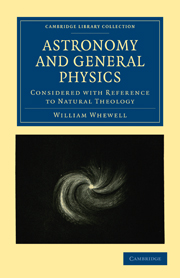Book contents
- Frontmatter
- NOTICE
- Contents
- INTRODUCTION
- BOOK I TERRESTRIAL ADAPTATIONS
- CHAP. I The Length of the Year
- CHAP. II The Length of the Day
- CHAP. III The Mass of the Earth
- CHAP. IV The Magnitude of the Ocean
- CHAP. V The Magnitude of the Atmosphere
- CHAP. VI The Constancy and Variety of Climates
- CHAP. VII The Variety of Organization corresponding to the Variety of climate
- CHAP. VIII The Constituents of Climate
- CHAP. IX The Laws of Heat with respect to Water
- CHAP. X The Laws of Heat with respect to Air
- CHAP. XI The Laws of Electricity
- CHAP. XII The Laws of Magnetism
- CHAP. XIII The Properties of Light with regard to Vegetation
- CHAP. XIV Sound
- CHAP. XV The Atmosphere
- CHAP. XVI Light
- CHAP. XVII The Ether
- CHAP. XVIII Recapitulation
- BOOK II COSMICAL ARRANGEMENTS
- BOOK III RELIGIOUS VIEWS
CHAP. V - The Magnitude of the Atmosphere
from BOOK I - TERRESTRIAL ADAPTATIONS
Published online by Cambridge University Press: 05 August 2011
- Frontmatter
- NOTICE
- Contents
- INTRODUCTION
- BOOK I TERRESTRIAL ADAPTATIONS
- CHAP. I The Length of the Year
- CHAP. II The Length of the Day
- CHAP. III The Mass of the Earth
- CHAP. IV The Magnitude of the Ocean
- CHAP. V The Magnitude of the Atmosphere
- CHAP. VI The Constancy and Variety of Climates
- CHAP. VII The Variety of Organization corresponding to the Variety of climate
- CHAP. VIII The Constituents of Climate
- CHAP. IX The Laws of Heat with respect to Water
- CHAP. X The Laws of Heat with respect to Air
- CHAP. XI The Laws of Electricity
- CHAP. XII The Laws of Magnetism
- CHAP. XIII The Properties of Light with regard to Vegetation
- CHAP. XIV Sound
- CHAP. XV The Atmosphere
- CHAP. XVI Light
- CHAP. XVII The Ether
- CHAP. XVIII Recapitulation
- BOOK II COSMICAL ARRANGEMENTS
- BOOK III RELIGIOUS VIEWS
Summary
The total quantity of air of which our atmosphere is composed is another of the arbitrary magnitudes of our terrestrial system; and we may apply to this subject considerations similar to those of the last section. We can see no reason why the atmosphere might not have been larger in comparison to the globe which it surrounds; those of Mars and Jupiter appear to be so. But if the quantity of air were increased, the structure of organized beings would in many ways cease to be adapted to their place. The atmospheric pressure, for instance, would be increased, which, as we have already noticed, would require an alteration in the structure of vegetables.
Another way in which an increase of the mass of the atmosphere would produce inconvenience would be in the force of winds. If the current of air in a strong gale were doubled or tripled, as might be the case if the atmosphere were augmented, the destructive effects would be more than doubled or tripled. With such a change, nothing could stand against a storm. In general, houses and trees resist the violence of the wind; and except in extreme cases, as for instance in occasional hurricanes in the West Indies, a few large trees in a forest are unusual trophies of the power of the tempest. The breezes which we commonly have are harmless messengers to bring about the salutary changes of the atmosphere, even the motion which they communicate to vegetables tends to promote their growth, and is so advantageous, that it has been proposed to imitate it by artificial breezes in the hothouse.
- Type
- Chapter
- Information
- Publisher: Cambridge University PressPrint publication year: 2009First published in: 1833



